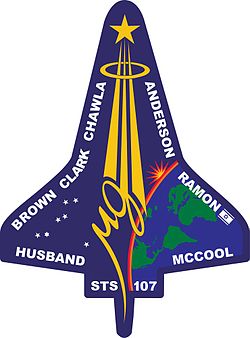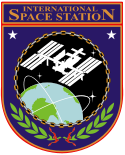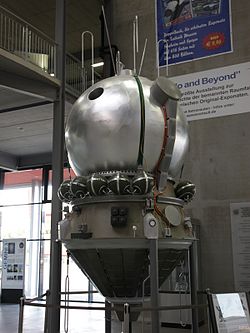STS-113
| STS-113 | |||||
 | |||||
| Uppdrag | 112 | ||||
|---|---|---|---|---|---|
| Rymdfärja | Endeavour (19)[1] | ||||
| NSSDC-ID | 2002-052A[2] | ||||
| Färdens tid | 13 dagar, 18 timmar, 48 minuter, 38 sekunder | ||||
| Uppskjutning | |||||
| Startplats | Pad 39A vid Kennedy Space Center i Florida | ||||
| Start | 24 november 2002, 00:49:47 UTC | ||||
| Landning | |||||
| Landningsplats | KSC Runway 33 | ||||
| Landning | 7 december 2002, 19:38:25 UTC | ||||
| Omloppsbana | |||||
| Varv | 215 st[3] | ||||
| Apogeum | 397 km | ||||
| Perigeum | 379 km | ||||
| Banlutning | 51,6° | ||||
| Sträcka | 9,0 miljoner km | ||||
| Rymdpromenad | |||||
| Antal | 3 st | ||||
| Total tid | 19 timmar, 55 minuter | ||||
| Dockning | |||||
| Rymdstation | ISS | ||||
| Dockning | 25 november 2002, 21:59 UTC | ||||
| Dockningsport | PMA-2 (Destiny, fram) | ||||
| Urdockning | 2 december 2002, 20:05 UTC | ||||
| Tid dockad | 6 dagar, 22 timmar, 51 minuter | ||||
| Besättning | |||||
| Befälhavare | Jim Wetherbee (6) | ||||
| Pilot | Paul S. Lockhart (2) | ||||
| Uppdragsspecialister | Michael López-Alegría (3) John Herrington (1) | ||||
 | |||||
| Kronologi Rymdfärjeprogrammet | |||||
| |||||
STS-113 var ett rymdfärjsuppdrag som genomfördes 2002 med rymdfärjan Endeavour. Den sköts upp från Pad 39A vid Kennedy Space Center i Florida den 24 november 2002. Efter nästan fjorton dagar i omloppsbana runt jorden återinträdde rymdfärjan i jordens atmosfär och landade vid Kennedy Space Center.
Flygningen gick till Internationella rymdstationen.
Flygningens mål var att leverera Truss P1 och installera den på Truss S0. Man bytte även besättningen på rymdstationen.
I och med att farkosten lämnade rymdstationen var Expedition 5 avslutad.
Se även
Referenser
- ^ NASA Space Shuttle Launch Archive Arkiverad 16 maj 2012 hämtat från the Wayback Machine., läst 28 juli 2016.
- ^ ”NASA Space Science Data Coordinated Archive” (på engelska). NASA. https://nssdc.gsfc.nasa.gov/nmc/spacecraft/display.action?id=2002-052A. Läst 22 mars 2020.
- ^ Manned Astronautics - Figures & Facts Arkiverad 4 mars 2016 hämtat från the Wayback Machine., läst 28 juli 2016.
Externa länkar
 Wikimedia Commons har media som rör STS-113.
Wikimedia Commons har media som rör STS-113.
| ||||||||
| |||||||||||||||||||||||||||||||
| ||||||||||||||||||||||||||||||||
Media som används på denna webbplats
This is the crew patch for the STS-113 mission, which will be the eleventh American (11A) assembly flight to the International Space Station (ISS). The primary mission will be to take the Expedition Six crew to the ISS and return the Expedition Five crew to Earth. STS-113 will be the first flight in the assembly sequence to install a major component in addition to performing a crew exchange. The Port 1 Integrated Truss Assembly (P1) will be the first truss segment on the left side of the ISS. P1 will provide an additional three External Thermal Control System radiators, adding to the three radiators on the Starboard 1 (S1) Integrated Truss Assembly. The installation and outfitting of P1 will require three extravehicular activities (space walks) as well as coordination between the Shuttle Robotic Manipulator System and the Space Station Robotic Manipulator System. The patch depicts the Space Shuttle Endeavour docked to the ISS during the installation of the P1 truss with the gold astronaut symbol in the background.
The seven stars at the top left center of the patch are the seven brightest stars in the constellation Orion. They represent the combined seven crew members (four Shuttle and three Expedition Six). The three stars to the right of the astronaut symbol represent the returning Expedition Five crew members. The Shuttle crew names are on the solar arrays of the P6 truss. The ISS Expedition crew names are in a chevron that also features the American and Russian flags. The Expedition 6 crew names are on top of the Expedition 5 crew names, since Expedition 6 goes up while Expedition 5 goes down. The Roman Numeral CXIII represents the mission number 113.Författare/Upphovsman: Pascal (Flickr user: pasukaru76), Licens: CC0
Vostok spacecraft replica at the Technik Museum Speyer, Germany.
Crew photo of STS-113
- In front are astronauts James D. Wetherbee (right) and Paul S. Lockhart, commander and pilot, respectively. Attired in training versions of the extravehicular mobility unit (EMU) space suits are astronauts Michael E. Lopez-Alegria (left) and John B. Herrington, both mission specialists.
In this illustration, a SpaceX Crew Dragon spacecraft approaches the International Space Station for docking. NASA is partnering with Boeing and SpaceX to build a new generation of human-rated spacecraft capable of taking astronauts to the station and expanding research opportunities in orbit. SpaceX's upcoming Demo-1 flight test is part of NASA’s Commercial Crew Transportation Capability contract with the goal of returning human spaceflight launch capabilities to the United States.
Backdropped by a blue and white Earth, this close-up view features the Soyuz TMA-6 spacecraft approaching the International Space Station (ISS). Onboard the spacecraft are cosmonaut Sergei K. Krikalev, Expedition 11 commander representing Russia's Federal Space Agency; astronaut John L. Phillips, NASA ISS science officer and flight engineer; and European Space Agency (ESA) astronaut Roberto Vittori of Italy. The Soyuz linked to the Pirs Docking Compartment at 9:20 p.m. (CDT) on April 16, 2005 as the two spacecraft flew over eastern Asia. The docking followed Friday’s launch from the Baikonur Cosmodrome in Kazakhstan.
The STS-112 emblem symbolizes the ninth assembly mission (9A) to the International Space Station (ISS), a flight which is designed to deliver the Starboard 1 (S1) truss segment. The 30,000 pound truss segment will be lifted to orbit in the payload bay of the Space Shuttle Atlantis and installed using the ISS robotic arm. Three space walks will then be carried out to complete connections between the truss and ISS. Future missions will extend the truss structure to a span of over 350 feet so that it can support the solar arrays and radiators which provide the electrical power and cooling for ISS. The STS-112 emblem depicts ISS from the viewpoint of a departing shuttle, with the installed S1 truss segment outlined in red. A gold trail represents a portion of the Shuttle rendezvous trajectory. Where the trajectory meets ISS, a nine-pointed star represents the combined on-orbit team of six shuttle and three ISS crew members who together will complete the S1 truss installation. The trajectory continues beyond the ISS, ending in a six-pointed star representing the Atlantis and the STS-112 crew.
Rotated and color enhanced version of original (ISS013-E-48788 (6 July 2006) --- The Space Shuttle Discovery approaches the International Space Station for docking but before the link-up occurred, the orbiter went through a series of inspection photos by station crew to inspect the vehicle for any damage to its Thermal Protection System. This was known as the Rendezvous Pitch Maneuver and was implemented after the Columbia Disaster in 2003. The Leonardo Multipurpose Logistics Module can be seen in the shuttle's cargo bay. Discovery docked at the station's Pressurized Mating Adapter 2 at 9:52 a.m. CDT, July 6, 2006.)











